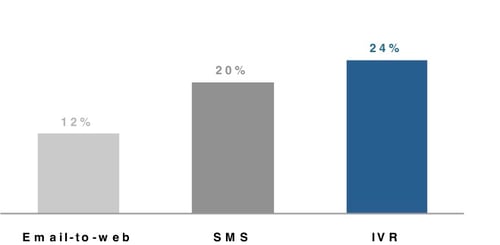
A case for IVR
A case for IVR
19 January 2015
IVR data collection continues to surprise me. Before explaining why, let’s take a step back and let me quickly explain what data collection via IVR looks like. An IVR survey consists of a series of pre-recorded questions, administered via phone. As an example, a “likelihood to recommend” question could be asked as follows:
How likely would you be to recommend [brand X] to a friend or family member on a scale of 1 to 5, where 1 means “Not at all likely to recommend” and 5 means “Extremely likely to recommend”? Please press any number between 1 and 5.
Administering a survey via IVR is a highly cost-effective approach when reaching out to respondents via phone is needed (e.g., when no email address is information is available for respondents). The question that usually comes up though is what response rates we’re seeing for IVR surveys. Doesn’t everyone hate these automated calls? Are respondents at all willing to do a survey via IVR?
And this is where the IVR continues to surprise me. As it turns out, respondents are quite open to completing a survey via IVR and for some demographics in particular, the response rates are actually quite staggering.
Here are some of the studies that convinced me of IVR’s ability to reach and engage respondents:
On one of our studies, we executed three data collection methodologies side-by-side: email-to-web, SMS, and IVR. The survey pertained to a recent visit to a retail store and the SMS and IVR methodologies reached out to respondents on their cell phones. The response rates (calculated as completed surveys / everyone invited) we saw were as follows:

Across the three data collection methodologies, the IVR obtained the highest response rate.
Certain demographics are more receptive to the IVR methodology than others though. To illustrate, on one of our studies we gave respondents different options for completing the survey, as follows:
- On Day 1, we sent respondents a text message that invited them to do the survey via SMS or via a mobile-optimized web survey
- On Day 2, we gave those who hadn’t responded to the invite a follow-up call via IVR

So while SMS is, not surprisingly, most popular among younger demographics, the IVR is most popular among older demographics and in particular among those 65 years old and older.
In light of this, a great example of the application of the IVR methodology is on a study for a home healthcare provider, whose client base consists largely of older demographics. On this study, we follow up with clients who recently received a call from the provider or who called the provider. The response rates here look as follows:

So depending on the service and the type of call the client made or received, the response rates we are seeing can be as high as 50%+.
One last powerful application of the IVR methodology is to access low-incidence populations. Trying to reach these populations using live interviewers can be quite cost-prohibitive. Advanis has leveraged the IVR methodology to reach a wide range of low-incidence populations, such as smokers, home healthcare users, and gym members.
In summary, the IVR methodology is a highly effective, and cost-effective methodology, in particular in cases where:
- The survey is short, e.g., for customer experience measurement programs
- Phone contact information is more readily available than email information
- Target respondents less tech-savvy (e.g., older demographics)
- The target population's incidence is low
Interested in an IVR for your company? Contact Matthijs Visser
(This article was published by Quirks in January 2015).
is a Principal Consultant with Advanis. Matthijs designs and leads ongoing customer experience projects, often involving high-volume data collection methodologies, sophisticated quota schemes, and developing online reporting solutions to serve a large number of end-users. He is passionate about finding solutions to each client’s unique challenges, whether they be technical, operational, or analytical.
Search / Recherche
Subscribe to our blog
Get our insights blog updates right to your mailbox once per month. No spam, we promise! Your email address is always safe.
Popular Tags
- ABpoll (1)
- Academics (1)
- Accessibility (3)
- Advertising (1)
- Analytics (8)
- API (1)
- Automation (2)
- Awareness (1)
- BC Food (1)
- Best Practices (9)
- BOS (1)
- Canada (11)
- Cannabis (2)
- Carbon Tax (1)
- Case Study (5)
- CATI (14)
- Choice (8)
- College (1)
- Communications (1)
- Concept Testing (2)
- Conference (5)
- Cordcutting (1)
- Covid-19 (2)
- CSAT (1)
- Customer Experience (12)
- Customer Journey (2)
- Dashboards (1)
- Data Science (2)
- Digital (1)
- Digital Adoption (1)
- DIY Research (2)
- Education (1)
- Email Marketing (1)
- Enviroment (1)
- Expectations (1)
- Finance (1)
- Foresight (2)
- Freelance (1)
- Future of Work (1)
- Gig Economy (1)
- Health (3)
- Human Experience (1)
- HX (1)
- Incentives (8)
- Innovation (6)
- Insights (26)
- Insurance (1)
- ISO (1)
- IVR (11)
- Learning (10)
- Longitudinal (1)
- Low Incidence Populations (2)
- Margin of Error (1)
- Market Research (35)
- Marketing (1)
- Marketing Primer (1)
- Millennial (8)
- Millennials (1)
- Mobile (17)
- MRX (21)
- newMR (1)
- NIS (1)
- NPS (10)
- Online Survey (9)
- Optimization (1)
- Persona (2)
- PMOT (1)
- Police Services (2)
- Pricing (3)
- Project Management (1)
- Public Policy (3)
- Qualitative (11)
- Quant (2)
- Quantitative (14)
- Research (4)
- Response rates (4)
- Responsive (8)
- Sampling (5)
- Security (1)
- Segmentation (2)
- Social Research (6)
- Strategy (1)
- Success (4)
- Survey (10)
- Surveying (3)
- Tips and Tricks (3)
- Trends (12)
- University (1)
- USA (1)
- UX (1)
- Virtual (1)
- WCAG (1)
- Webinar (1)

